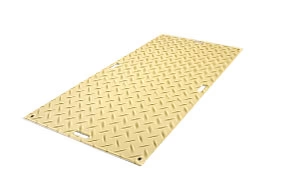The foundation of any residential property is more than just bricks and mortar; it extends beneath the surface, encompassing the delicate balance of landscaping, infrastructure, and environmental sustainability.
In this comprehensive exploration, we delve into the world of plastic ground construction mats, uncovering their crucial role in safeguarding residential properties.
From protecting lawns and golf courses to ensuring safety in pool areas and heavy mud zones, these unassuming yet robust mats play a pivotal role in maintaining the integrity and aesthetics of our homes.
Introduction to Plastic Ground Construction Mats
Before we embark on the journey of understanding how plastic ground construction mats safeguard residential properties, let’s acquaint ourselves with these unsung heroes.
Plastic ground construction mats, often crafted from high-density polyethylene (HDPE) or composite materials, are durable sheets strategically placed on the ground to provide a stable and protective surface.
Their applications extend far beyond construction sites, proving invaluable in preserving the grounds of residential areas.
Preserving the Pristine: Lawns and Gardens
For homeowners, the allure of a lush, green lawn is undeniable. However, ongoing maintenance and various activities can take a toll on the delicate grass and soil.
Plastic ground protection mats act as guardians of lawns, preventing soil compaction and minimizing damage caused by heavy foot traffic, machinery, or construction projects.
By distributing weight evenly, these mats help maintain a pristine appearance, turning lawns into resilient green spaces.
Enhancing Safety in Pool Areas
Residential pool areas are hubs of recreation and relaxation, but they also pose unique challenges when it comes to maintenance and construction.
Plastic ground construction mats offer a stable foundation, especially crucial when heavy equipment is involved in pool installations or repairs.
These mats create temporary roadways, ensuring that heavy machinery doesn’t damage the surrounding landscape or compromise the safety of the pool structure itself.
Golf Courses
Golf courses are meticulously designed landscapes that require careful maintenance to preserve their beauty and playability.
Plastic ground construction mats prove invaluable in this context by providing a protective layer during maintenance work, preventing damage to the finely manicured turf.
Whether it’s routine care or more extensive renovations, these mats enable golf course professionals to navigate the terrain without leaving a lasting impact.
Navigating Heavy Mud Areas
Some residential properties face the challenge of heavy mud areas, particularly in regions with diverse climates. Plastic ground construction mats come to the rescue, creating stable pathways over muddy terrain.
Whether it’s the delivery of heavy equipment, landscaping projects, or routine maintenance, these mats ensure that the mud does not impede progress, preventing damage to both property and machinery.
Arborists’ Ally
Residential properties often feature trees that require care and maintenance. Arborists, tasked with the responsibility of tree work, find a reliable ally in plastic ground construction mats.
These mats create stable work surfaces, minimizing soil compaction around tree roots and protecting the underlying ground.
With the support of these mats, arborists can carry out their work efficiently without compromising the health of the trees or causing unnecessary disturbance to the surrounding landscape.
Water Drilling Warriors
Residential areas may undergo water drilling projects for various reasons, such as installing wells or addressing water-related issues.
Plastic ground construction mats play a crucial role in supporting water drilling operations by providing a stable platform for drilling equipment.
They safeguard the property from potential damage, ensuring that drilling activities are conducted efficiently and without adverse effects on the surrounding environment.
Eco-Friendly Land Management
As environmental consciousness grows, so does the demand for eco-friendly solutions in residential land management.
Plastic ground construction mats align with this trend, offering a sustainable approach to property maintenance.
By minimizing soil disturbance and preventing erosion, these mats contribute to eco-friendly land management practices, allowing homeowners to balance their desire for well-kept properties with a commitment to environmental stewardship.
Versatility in Residential Applications
The versatility of plastic ground construction mats extends beyond specific use cases, making them valuable assets in various residential applications.
Whether it’s a home renovation project, landscape redesign, or the installation of outdoor amenities, these mats provide a stable surface that safeguards the property and preserves its aesthetics.
Their adaptability makes them indispensable tools for homeowners seeking efficient and damage-free solutions.
Balancing Aesthetics and Functionality
Ultimately, the use of plastic ground construction mats in residential properties reflects a delicate balance between aesthetics and functionality.
Homeowners aspire to maintain visually appealing landscapes while ensuring that necessary maintenance and construction activities do not compromise the integrity of their properties.
Plastic ground construction mats emerge as key players in achieving this equilibrium, offering a practical solution that safeguards the beauty of residential grounds.
Conclusion
In the realm of residential properties, where the ground beneath our feet holds the key to a harmonious living environment, plastic ground construction mats prove to be silent guardians.
From protecting lawns and gardens to enhancing safety in pool areas, golf courses, and heavy mud zones, these mats play a multifaceted role in preserving the integrity and aesthetics of our homes.
As homeowners increasingly prioritize sustainable and eco-friendly practices, the role of plastic ground construction mats becomes even more significant, reflecting a commitment to responsible land management.





























